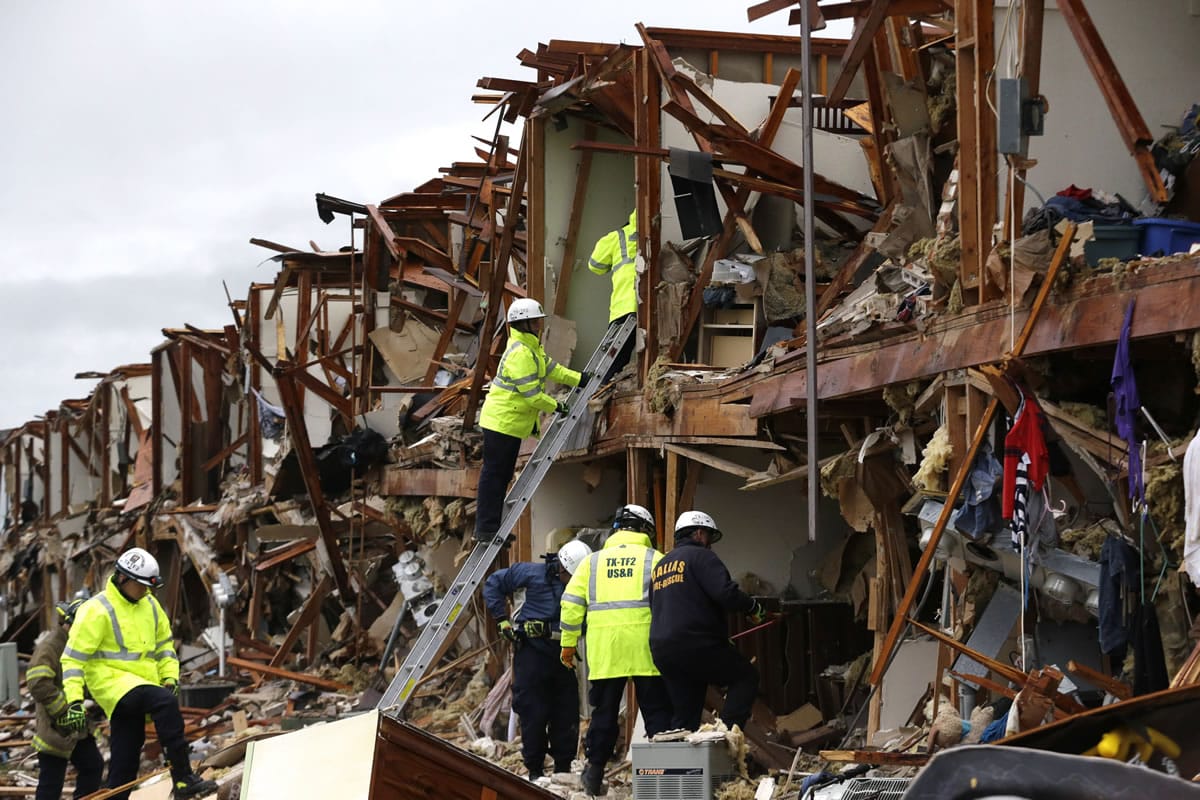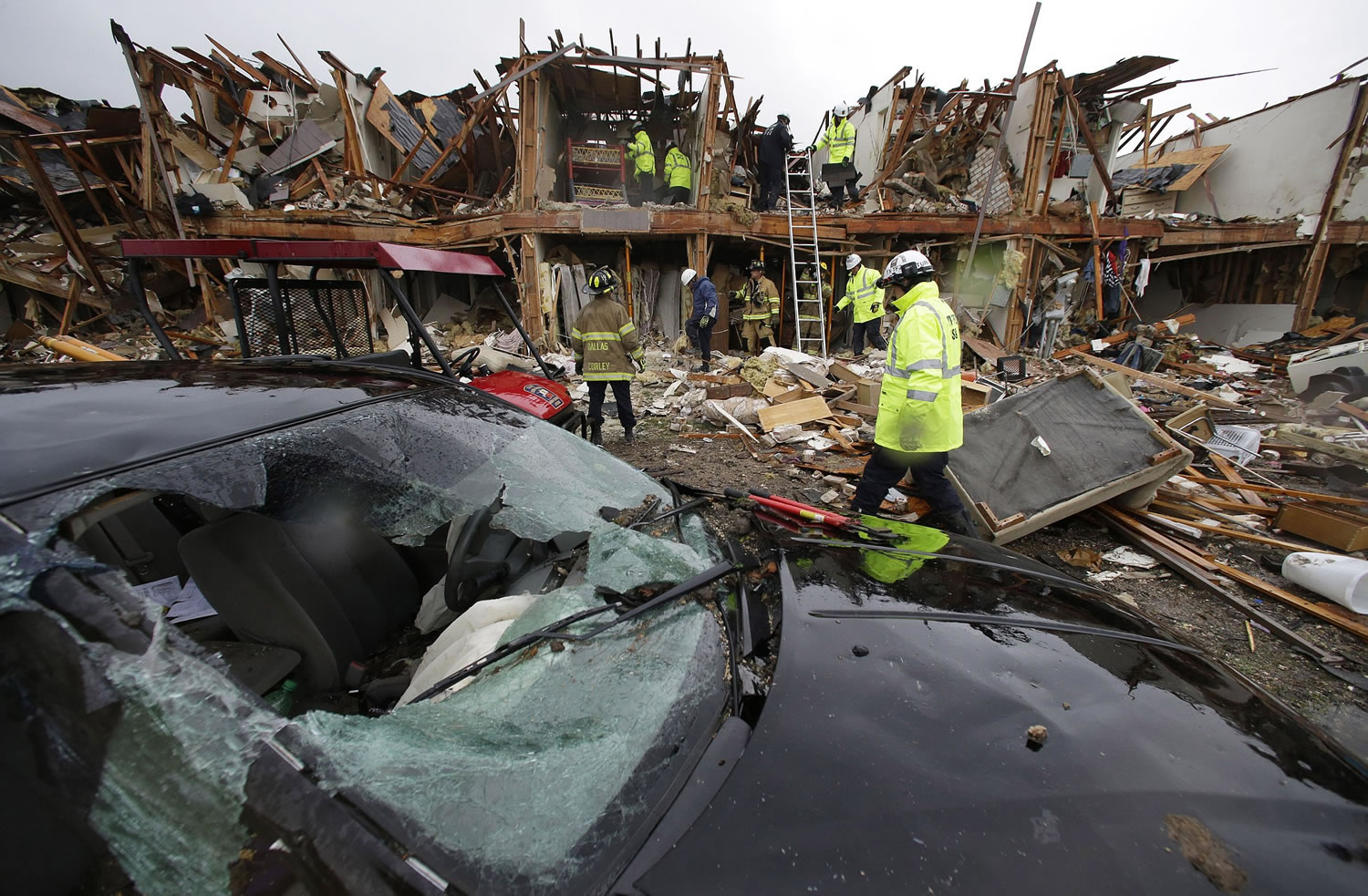WEST, Texas — Rescuers searched the smoking remnants of a Texas farm town Thursday for survivors of a thunderous fertilizer plant explosion, gingerly checking smashed houses and apartments for anyone still trapped in debris while the community awaited word on the number of dead.
Initial reports put the fatalities as high as 15, but later in the day, authorities backed away from any estimate and refused to elaborate. More than 160 people were hurt.
A breathtaking band of destruction extended for blocks around the West Fertilizer Co. in the small community of West. The blast shook the ground with the strength of a small earthquake and crumpled dozens of homes, an apartment complex, a school and a nursing home. Its dull boom could be heard dozens of miles away from the town about 20 miles north of Waco.
Waco police Sgt. William Patrick Swanton described ongoing search-and-rescue efforts as “tedious and time-consuming,” noting that crews had to shore up much of the wreckage before going in.
There was no indication the blast, which sent up a mushroom-shaped plume of smoke and left behind a crater, was anything other than an industrial accident, he said.
The explosion was apparently touched off by a fire, but there was no indication what sparked the blaze. The company had been cited by regulators for what appeared to be minor safety and permitting violations over the past decade.
The Wednesday night explosion rained burning embers and debris down on terrified residents. The landscape Thursday was wrapped in acrid smoke and strewn with the shattered remains of buildings, furniture and personal belongings.
Firefighter Darryl Hall choked up as he described the search.
“You’re strong through it because that’s your job. That’s what you’ve been trained to do. But you’re reminded of the tragedy and your family. And that it could be you,” Hall said. “Then it’s a completely different story.”
While the community tended to its deep wounds, investigators awaited clearance to enter the blast zone for clues to what set off the plant’s huge stockpile of volatile chemicals.
“It’s still too hot to get in there,” said Franceska Perot, a spokeswoman for the Bureau of Alcohol, Tobacco, Firearms and Explosives, later adding that she wasn’t sure when her team would be able to start its investigation.
The precise death toll was uncertain. Three to five volunteer firefighters initially were believed to be among the dead, which authorities said could number as many as 15. But the state Department of Public Safety later said the number of fatalities couldn’t be confirmed.
The Dallas Fire-Rescue Department said one of its off-duty firefighters, Capt. Kenny Harris, was among those killed. Harris — a 52-year-old married father of three grown sons — lived in West and had decided to lend a hand to the volunteers battling the blaze.
The many injuries included broken bones, cuts and bruises, respiratory problems and minor burns. A few people were reported in intensive care and several more in critical condition.
First-responders evacuated 133 patients from the nursing home, some in wheelchairs. Many were dazed and panicked and did not know what happened.
William Burch and his wife, a retired Air Force nurse, entered the damaged nursing home before first-responders arrived. They searched separate wings and found residents in wheelchairs trapped in their rooms. The halls were dark, and the ceilings had collapsed. Water filled the hallways. Electrical wires hung eerily from the ceilings.
“They had Sheetrock that was on top of them. You had to remove that,” Burch said. It was “completely chaotic.”
Gov. Rick Perry called the explosion “a truly nightmare scenario for the community” and said he had been in touch with President Barack Obama, who promised his administration’s assistance with operations on the ground.
Authorities said the plant handles both the fertilizers anhydrous ammonia and ammonium nitrate, the latter of which was used in the 1995 Oklahoma City bombing and several other attacks, such as the first bombing attempt at the World Trade Center in 1993.
Ammonium nitrate makes big explosions, be they accidental or intentional, said Neil Donahue, professor of chemistry at Carnegie Mellon University. It is stable, but if its components are heated up sufficiently, they break apart in a runaway explosive chemical reaction, he said.
“The hotter it is, the faster the reaction will happen,” he said. “That really happens almost instantaneously, and that’s what gives the tremendous force of the explosion.”
About a half-hour before the blast, the town’s volunteer firefighters had responded to a call at the plant, Swanton said. They immediately realized the potential for disaster because of the plant’s chemical stockpile and began evacuating the surrounding area.
The blast happened 20 minutes later.
The U.S. Chemical Safety Board was deploying a large investigation team to West. The ATF team that investigates all large fires and explosions was bringing fire investigators, certified explosives specialists, chemists, canines and forensic specialists. American Red Cross crews were helping evacuated residents.
Records reviewed by The Associated Press show the U.S. Pipeline and Hazardous Materials Safety Administration fined West Fertilizer $10,000 last summer for safety violations that included planning to transport anhydrous ammonia without a security plan. An inspector also found the plant’s ammonia tanks weren’t properly labeled.
The government accepted $5,250 after the company took what it described as corrective actions, the records show. It is not unusual for companies to negotiate lower fines with regulators.
In a risk-management plan filed with the Environmental Protection Agency about a year earlier, the company said it was not handling flammable materials and did not have sprinklers, water-deluge systems, blast walls, fire walls or other safety mechanisms in place at the plant.
State officials require all facilities that handle anhydrous ammonia to have sprinklers and other safety measures because it is a flammable substance, according to Mike Wilson, head of air permitting for the Texas Commission on Environmental Quality.
But inspectors would not necessarily check for such mechanisms, and it’s not known whether they did when the West plant was last inspected in 2006, said Ramiro Garcia, head of enforcement and compliance.
That inspection followed a complaint about a strong ammonia smell, which the company resolved by obtaining a new permit, said the commission’s executive director Zak Covar. He said no other complaints had been filed with the state since then, so there haven’t been additional inspections.
A woman who answered the phone at the home of plant owner Don R. Adair said he wasn’t feeling well and would not be available for comment.
The federal Chemical Safety Board has not investigated a fertilizer plant explosion before, but Managing Director Daniel Horowitz said “fertilizers have been involved in some of the most severe accidents of the past century.”
He noted the 2001 explosion at a chemical and fertilizer plant that killed 31 people and injured more than 2,000 in Toulouse, France. The blast in a hangar containing 300 tons of ammonium nitrate came 10 days after the Sept. 11, 2001, terrorist attacks, raising fears at the time that the two could be linked. A 2006 report blamed the blast on negligence.
Horowitz also mentioned a disaster in Texas City in 1947, when a cargo ship holding more than 2,000 tons of ammonium nitrate caught fire and exploded, killing more than 500 people.




